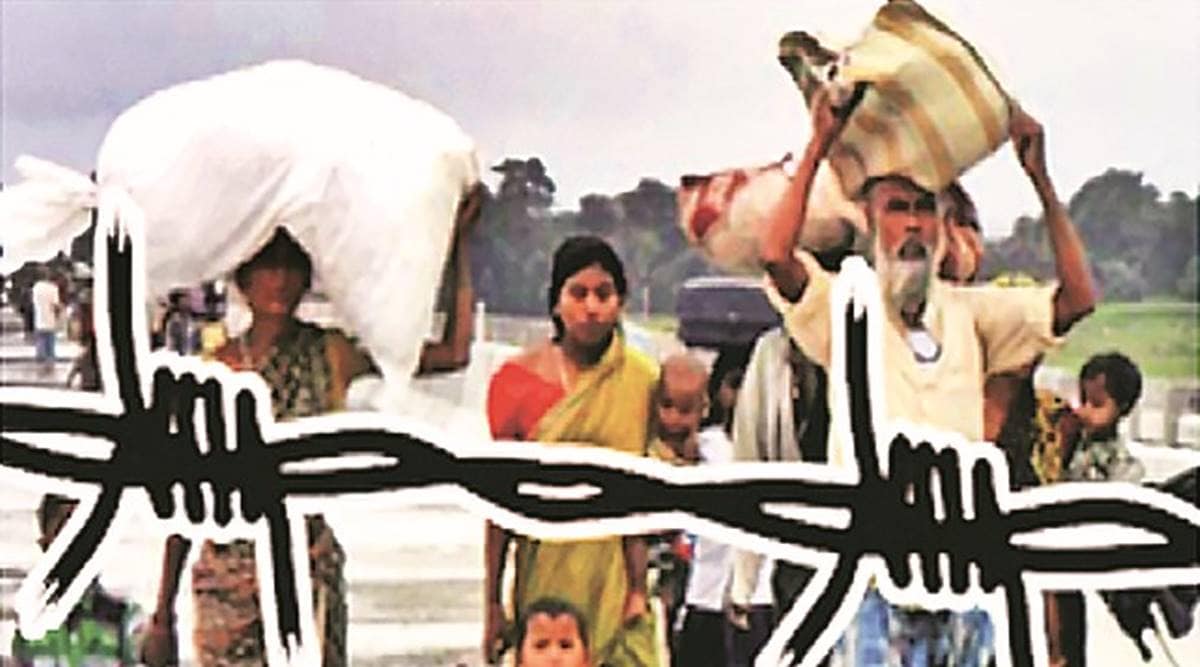 The photograph on the government website.
The photograph on the government website. At 10.30 am on July 24, 2012, a few days into one of Assam’s worst sectarian riots, between the Bodos and Bengali-speaking Muslims, photographer and journalist Abdul Maleque Ahmed had found himself on the half-constructed Hagrama bridge in Chirang district.
As scores of people fled from burning villages on one side to safe ground across the bridge, Ahmed had clicked a photo of a group of displaced men, women and toddlers, bag and baggage in hand. The photograph ran in the front page of the Assamese daily he worked for.
Over the next few months, Ahmed’s picture became the most circulated photograph of the ‘2012 BTAD (Bodoland Territorial Area Districts) riots’, which had left nearly 100 people dead and 4 lakh displaced. “I found some of the people from the photo in a relief camp a few days later… they were in a bad way. Many newspapers used that photo… I felt everyone should empathise with the pain these people had gone through,” he says.
However, Ahmed, who now works at a local news channel, wasn’t prepared for where the photo surfaced recently. Last month, to his “huge shock”, he saw the photograph, with an illustration of a barbed wire superimposed on it, on the website of the Assam government’s Home Political Department, on a page about ‘Foreigners’ Tribunals (FTs)’.
FTs are quasi-judicial bodies that adjudicate citizenship in Assam, and are now the last recourse for the 19 lakh excluded from the contentious National Register of Citizens.
Monowar Hussain, a journalist and activist in Bongaigaon district, first came across the photo on the government website. He says he immediately contacted Ahmed, and tracked down the family captured in the photo — a woman and three children — to Bhawanipur village in Chirang district.
Ibrahim Ali, 39, whose mother and siblings were in the photo, told The Sunday Express it was a shock to see his family portrayed as “bidexis (foreigners)”. It brought back memories of those dark days of 2012. “We had managed to flee just before our houses were burned,” he said. The family could return home only after nine months spent in a relief camp.
“If people go to the website and see the photo.. isn’t that what they will think (that we are foreigners)? But all our papers are in order, our names in the NRC too,” Ibrahim says.
On Saturday, the All Assam Minority Students’ Union (AAMSU) addressed a memorandum to the Chief Secretary of Assam asking for removal of the picture, which they described as a “symbolic portrayal of Indian citizens as foreigners”. “A picture of a family residing in Village-Bhawanipur under Bijni Revenue Circle of Chirang district has been portrayed as foreigners in the official website of the home and political department… Such portrayal of genuine Indian citizens as foreigners by the government of Assam is outrageous, unconstitutional, illegal and undermines the sanctity of the department.”
AAMSU president Rejaul Karim Sarkar said when people “see daari, topi, lungi (beard, cap, sarong), they immediately think Bangladesh”. “They do not bother to fact check, to investigate if they are actually foreigners.” Sarkar claimed that the photo also comes up when one searches for any article on the ‘foreigner issue’ in Assam. “When in reality the family are displaced riot victims… who have documents from 1951.”
Niraj Verma, Principal Secretary to the Government of Assam, said he needed to “check the photograph” before he commented. “I am not aware of the memorandum but let me check what photograph it was,” he said.
Ahmed hopes he doesn’t end up regretting the photo. “I had taken it to help the people concerned. The irony is that now the photo is synonymous with being bidexi.”
- The Indian Express website has been rated GREEN for its credibility and trustworthiness by Newsguard, a global service that rates news sources for their journalistic standards.

